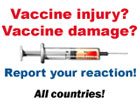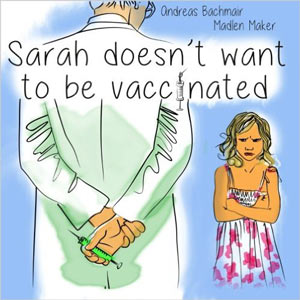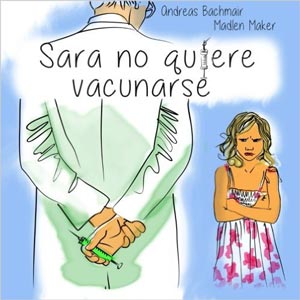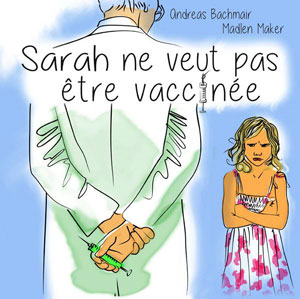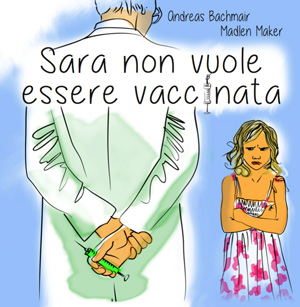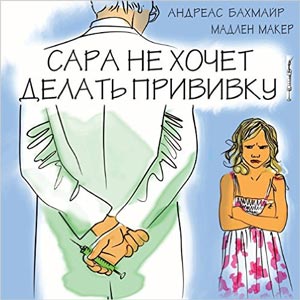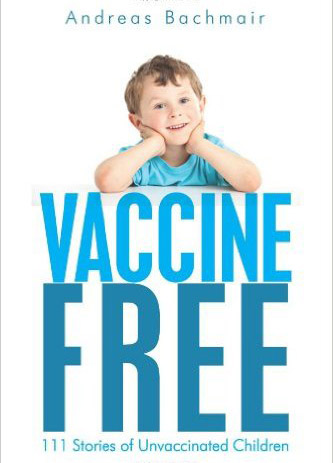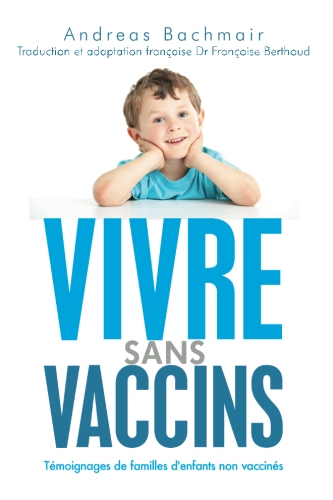Smallpox vaccination
Vaccine
The vaccinia virus is used for the vaccination. Its origin has not been conclusively determined. It is a virus that is of a lower degree of pathogenity.
The vaccines available today are largely from old inventories which are no longer approved. This means that they were not further developed during the last twenty years in order to increase the vaccine safety. It was not until late 2001, after a real terrorist threat, that people started working on them again.
The majority of vaccine inventories available today and the vaccine used in the WHO campaign consists of cell material which was scratched off the skin of animals infected with vaccinia – mainly calves or sheep – to which Phenol is added in a concentration which kills off bacteria but which does not inactivate the Vaccinia virus (VACV). The vaccine is then freeze-dried and stored in sealed ampoules. Before the vaccination the powder is dissolved in a sterile buffer and inserted into the skin with several pricks of a jagged needle which causes the characteristic scar on the upper arm.
Nowadays smallpox vaccinations are produced in cell cultures with chicken fibroblasts, minimizing the danger of contamination compared to the past when smallpox vaccine was produced on calf skin. The danger of unwanted side effects is about as large as with the vaccine used in the 70s, including permanent damage to the central nervous system in one out of one million people vaccinated whose immune system is compromised (http://www.aerztezeitung.de/docs/2003/01/17/009a0203.asp?cat=/medizin/impfen)
Previous production methods for vaccinations do not meet the current Good Manufacturing Practice, ( (cGMP) for vaccinations. The new generation of vaccines is produced by a cell culture technology in a serum-reduced, serum-free or completely protein-free medium. The risk of contamination with pathogens such as BSE is therefore minimal and ideally is non existent. Safety and effectivity must be evaluated compared to the first generation vaccines within the global extinction program.
Immunity
In view of a threat by smallpox bio weapons the question is whether people who were vaccinated decades ago are vaccine-protected.
The immunologist Jeffrey Frelinger examined blood samples of 13 laboratory technicians who were vaccinated against the smallpox. He tested how CD8-cells reacted to being in contact with vaccinia viruses. CD8 lymph cells prevent a virus infection from expanding by recognizing and killing cells which have been infected; when they do they also release Gamma-Interferon. Among those who had been vaccinated five years prior 6.5 percent of the CD8 cells produced interferon after contact with the vaccine viruses. If the vaccination was administered 35 years earlier, it amounted to 4.8%. „It is surprising that the loss of activity is so slight“, the researches said. (Die Welt:Eine Pocken-Impfung gibt jahrzehntelangen Schutz 5.9.2002)
The group that was investigated, however, is very small. Whether the results are transferable cannot be said with certainty. Moreover, the test was for the activity of vaccinia viruses and not smallpox viruses.
The journal Ärztezeitung reports that there is no life-long immunity after a vaccination and that it only lasts several years. It is different in endemic areas where protection was observed to last for 20 years. 25-30 year olds today have a lower degree of immunity than during the first two years after the vaccination but at least it protects against the complications of a virus infection.(http://www.aerztezeitung.de/docs/2003/01/17/009a0203.asp?cat=/medizin/impfen)
Whether the vaccination is even effective is controversial today. An interesting article on the effectiveness of smallpox vaccinations was published in February 2003 in the Townsend Letter for Doctors and Patients.
Vaccination complications and vaccination damages
"Serious vaccination side effects are much more frequent after smallSmallpox vaccinations than from other vaccinations“, says Professor John Neff of the Children’s Hospital in Seattle in Washington. (Ärzte Zeitung, 23.10.2002)
When the vaccination was still routine there was one death for every 1000000 million vaccinations (in Australia 1-5:100000 (Feery Adverse reactions after smallSmallpox vaccination.BJMed J Aust 1977 Aug 6;2(6):180-3 Related Articles) there was one death and 1 in 10000 developed very serious side effects such as Encephalitis, severe skin disorders and other organ manifestations. Encephalitis occurred in a rate of 1:110000 (Roos KL, Eckerman NL.The smallSmallpox vaccine and postvaccinal Encephalitis.Semin Neurol 2002 Mar;22(1):95-8 )
Official numbers and facts released by the CDC(http://www.bt.CDC.gov/agent/smallSmallpox/vaccination/reactions-vacc-public.asp):
Normal and typically mild reactions (which disappear without treatment):
- Pain at the injection site
- Pain and swelling of the lymph nodes in the arm pit.
- Slight fever.
- One person in three is so sick that they have to stay at home to get better
Grave side effects
In the past there were serious side effects in approx. every one thousandth person in one million who had been vaccination. These side effects necessitated medical treatment:
- Outbreak of Vaccinia eczema (see below) which, however, is limited to one skin area, usually the genitals or the face, but also the eyes where at worst it can lead to blindness. Therefore the CDC recommends washing your hands after touching the injection site of the vaccination. Eruption of vaccinia eczema all over the body (generalized vaccinia).
- Toxic or allergic eczema
Life-threatening side effects
Occurs in 14-52 per 1 million vaccinated persons (initial vaccination). Immediate medical treatment necessary.
- Eczema vaccinatum. Serious eczema caused by infection of almost all of the skin in persons with skin problems such as eczema or atopic dermatitis
- Vaccinia necrosum. Destroys the skin, usually ends in death.
- Post-vaccinous encephalitis.
Important note: The CDC warns that the data on the side effect rates are based on two trials from 1968 and are probably no longer applicable today. The side effect rate in the USA could be higher as there are more people who suffer from an immune sickness (cancer, cancer therapy, organ transplantation, HIV, AIDS….) or from skin diseases.
The administration of the vaccine is particularly problematic for persons whose immune system is compromised. In other words, persons who are HIV positive (in the United States 300000 people), for people who take immune suppressive medications or who suffer from auto immune diseases or cancer, the vaccination can trigger the most severe kinds of side effects
Pregnant women and children younger than two years of age should not be vaccinated.
But the vaccination eczema occurs not only in these very severe cases but in all persons who suffer from an eczema of the skin, which means millions of people. This skin disease which is accompanied by a high fever and a eczema can even lead to death.(WILLIAM J. BROAD:A LIVING WEAPON The New York Times/Engler RJ, Kenner J, Leung DY.Smallpox vaccination: Risk considerations for patients with atopic dermatitis.J Allergy Clin Immunol 2002 Sep;110(3):357-65 Related Articles, Links )
The CDC (Center for Disease Control) in the United States therefore recommends that all people who suffer from the above-mentioned diseases or who take immune-suppressive medications should only be vaccinated if they are sure that they will come into contact with the virus (Mary Carmichael, Facing Up To lSmallpox. , Newsweek, 10-07-2002, pp)
Vaccinia
Due to the fact that this vaccination is a live vaccination the virus can also be transmitted to other people. People who have been vaccinated thus represent a source of secretion as the vaccinia vaccination virus is secreted via the vaccination lesions (JAMA 288, 2002, 1901). This poses a great problem in the United States as the intention is to vaccinate all people who work in hospitals, placing all people who were not vaccinated at an enormous risk of contracting vaccinia, especially if they suffer from an immune deficit. (A Different View of Smallpox and Vaccination,Thomas Mack, M.D., M.P.H.n engl j med348;5www.nejm.org january 30, 2003)


